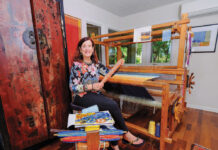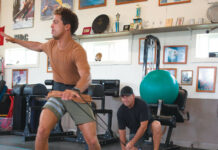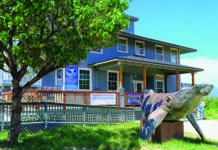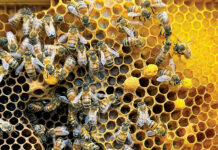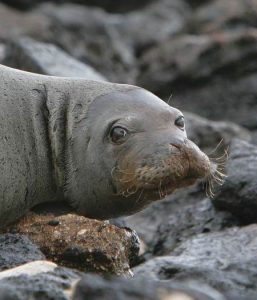 Down for the Count?
Down for the Count?
It’s Saturday morning and we’re picking our way along a North Shore Maui beach, tally sheet in hand, looking for Hawaiian monk seals. Conducted by the National Oceanic and Atmospheric Administration (NOAA), the semiannual Hawaiian Monk Seal Count invites volunteers throughout the Islands to help locate a species even more endangered than the humpback whale.
The entire monk seal population is only around 1,200, and in the Northwestern Hawaiian Islands, that number is declining. Threats include habitat loss, marine debris, and shark predation. But here, among the major Hawaiian Islands, the population is growing.
Nicole Davis, NOAA’s Maui Marine Mammal Response coordinator, runs a hotline for monk-seal sightings countywide. “We want people to report any and all sightings,” she says. “If a seal’s on shore where there are lots of people, we’ll tape the area off. Our volunteers stay and provide onsite education. The seals come ashore to rest, so it’s important that people not approach them.”
Davis also organizes the Hawaiian Monk Seal Count for Maui County. “It’s a statewide event,” she says. “We all count at the same time on the same day, which gives us a picture of where the seals are at a specific moment in time, while raising public awareness of the need for responsible stewardship.”
To join the count, scheduled for Wednesday, April 19, call Davis at 292-2372.
War & Peace:The Exhibit
Taking its cue from the Tolstoy classic about Russian war and society made sense for last summer’s War & Peace art exhibit, which featuring over 200 antiwar pieces by Maui artists, among them Tom Sewell, Janet Davis and Ed Lane; as well as works by internationally renowned artists like Sandow Birk. Coordinators Michelle Sewell and Tim Garcia orchestrated an event that, like its namesake, reflects the relationship between war and community. Since the success of the June exhibit, Sewell and Garcia have new ambitions: transforming War & Peace from a cross-section of local antiwar art to one of national scope.
Sewell and Garcia were initially dismayed when fellow artists’ politically and emotionally charged work was rejected by local galleries. “None of the galleries where we sell our art would be interested in something controversial,” says participating artist Melissa Chimera. “Controversial” pieces ranged from flags with faces of over 3,000 American soldiers killed in action, to ceramic “Love Bombs.”
Garnering help from private donors and nonprofit organizations, Sewell and Garcia rented a space on Makawao Avenue and launched a three-week event that attracted over 150 visitors daily to both the exhibit and nightly events like poetry slams and musical performances.
The show’s high attendance and the media attention it attracted gave its coordinators momentum “to create a growing, rolling art show from the West Coast to Washington D.C.,” says Garcia. The first stop? Venice, California.
Because each show costs an estimated $10,000, from artwork storage to travel expenses, only 35 percent of the Makawao exhibit will travel on the Mainland. Nonetheless, as the exhibit moves across the country, Sewell and Garcia plan to add artists by enlisting each host gallery to do a call for art.
The exhibit is slated to appear in Austin, Texas, March 1 through 21. Garcia and Sewell hope to secure funds for shows in Portland, San Francisco, Denver and Minneapolis during the Democratic and Republican national conventions, and in Washington D.C. for the presidential election.
For War & Peace’s latest Mainland schedule, visit www.warandpeaceartshow.com
—Nicole Crane
Green in the Limelight
Increased awareness of global warming is still sparking conversation nearly a year after overflow crowds flocked to the Maui Arts & Cultural Center for the Focus Green Lecture Series, which featured such high-profile leaders in environmental stewardship as Robert Kennedy Jr., Dr. David Suzuki, and James Howard Kunstler. “I can’t go to a party now that I don’t have to discuss these problems,” says Maui renewable-energy pioneer Laf Young, who’s also noticed a boom in local solar-power business.
A second Focus Green Lecture Series is scheduled for this spring, featuring six of the country’s leading environmentalists. Luminaries include Amory Lovins, whose Rocky Mountain Institute helps Fortune 500 companies go green, and who has been a leader in seeking positive solutions to the energy crisis for more than thirty years; and William Nye, scientist, inventor, comedian, author . . . and the man your kids know as TV’s “Bill Nye, the Science Guy.” (See our calendar for speakers, dates and times.)
Lovins, in particular, has studied specific problems we face as an isolated island community. In August of 2007, Rocky Mountain Institute was commissioned by the Dowling Company to conduct a charrette entitled “A Sustainable Vision for Makena.” During the charrrette, Lovins introduced and discussed numerous opportunities for technologies and practices that would support a sustainable community for Makena.
Don’t miss this opportunity to hear some of the most renowned environmental leaders in the country.
A $5 admission charge will directly benefit Maui Coastal Land Trust. (Students with valid IDs are free.) For information call 270-0516.

